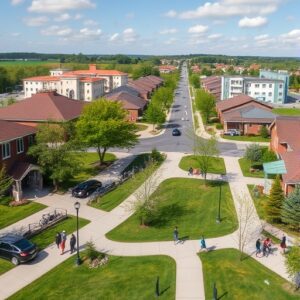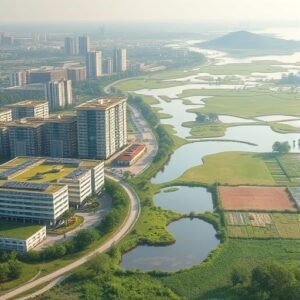Transforming Terrain: The Top 5 Benefits of Land Development You Need to Know
I. Introduction to Land Development
A. Definition and Overview
Land development refers to the processes involved in preparing land for construction or use, which includes everything from buying undeveloped land to turning it into residential communities, shopping areas, or parks. Types of land development projects can include residential subdivisions, commercial centers, and industrial facilities.
B. Historical Context
Historically, land development has evolved alongside human civilization, reflecting changing needs and technologies. It plays a crucial role in community planning, influencing everything from transportation to housing. Understanding this evolution helps us appreciate the thoughtful design behind the places we live and work today.
C. Importance of Understanding Land Development
As cities expand and populations grow, comprehending land development becomes increasingly relevant. It shapes modern city layouts, impacts local economies, and fosters environmental stewardship. By grasping its significance, we can better participate in discussions about community improvements and sustainability.
II. Economic Growth and Job Creation

A. Stimulating Local Economies
Land development can significantly contribute to local economies. When new projects break ground, they inject money into the community, leading to increased business for local shops and services. For example, the recent development of a shopping center in a previously undeveloped area resulted in a 15% boost in local business revenue.
B. Job Opportunities
New projects create numerous job opportunities, both directly and indirectly. When construction begins, workers such as architects, builders, and engineers are hired. Furthermore, supporting industries like transportation, logistics, and retail flourish as the population increases.
C. Attraction of Investment
Newly developed areas often attract outside investors looking for opportunities in a growing market. This influx of investment can benefit local governments too, as they reap the rewards from increased property taxes and services, helping improve community facilities.
III. Enhancing Community Infrastructure

A. Improvement of Public Services
Development projects often bring essential services to communities, such as new schools and hospitals. For instance, a recent housing development included a new elementary school, directly benefiting families in the area. Additionally, infrastructure improvements, like better roads and public transport, enhance the quality of life for residents.
B. Increased Property Values
When new developments are completed, property values in the area tend to rise. This boost is particularly evident in neighborhoods where investment leads to modernization and increased desirability. For example, the revitalization of a downtown area in a midsized city saw property values climb by over 30% in just two years.
C. Sustainability Initiatives
Modern land development increasingly includes sustainability initiatives, such as incorporating green spaces and promoting eco-friendly construction practices. This not only beautifies an area but also supports local biodiversity, making communities healthier.
IV. Revitalization of Urban Areas

A. Addressing Urban Decay
Land development plays a vital role in revitalizing urban neighborhoods. Projects can turn neglected areas into vibrant spaces that restore pride and economic vitality. Case studies, like the transformation of a derelict warehouse district into a popular cultural hub, showcase the power of strategic investments.
B. Attraction of New Residents
New developments can draw residents back to urban centers, reinvigorating communities and local economies. By offering modern living spaces, shops, and services, these projects make city life appealing again, balancing new amenities with the needs of existing residents.
C. Fostering Community Engagement
Involving local residents in the planning process fosters a sense of community. Incorporating feedback from neighbors creates developments that resonate with local values and needs, making residents feel valued and connected.
V. Environmental and Land Use Management

A. Land Conservation
Thoughtful land use planning helps conserve valuable green spaces, reducing the threat of urban sprawl. By promoting dense, mixed-use developments, planners can protect natural environments and maintain a balance between urban and rural areas.
B. Environmental Restoration
Land development offers opportunities for environmental restoration. Many projects now focus on revitalizing degraded landscapes, which can restore local ecosystems. For instance, transforming a former industrial site into a public park enhances both biodiversity and community well-being.
C. Resilience to Climate Change
Designing developments that withstand environmental challenges—like flooding or rising temperatures—is becoming essential. Many new projects incorporate green infrastructure, such as rain gardens and permeable pavements, which can mitigate climate impacts while enhancing urban aesthetics.
VI. Conclusion

Land development brings a wealth of benefits that extend far beyond the surface. From boosting local economies to restoring urban areas and managing our environment, understanding these benefits helps us appreciate the importance of smart, thoughtful development in our communities.
VII. Frequently Asked Questions (FAQs)
A. What is land development?
Land development is the process of changing land to better suit human needs, including building homes, businesses, and infrastructure.
B. How does land development benefit existing communities?
It enhances local economies, creates jobs, improves infrastructure, and promotes community engagement.
C. What are the environmental considerations in land development?
Planners must think about land conservation, ecological impacts, and sustainable practices to ensure that development supports rather than harms the environment.
D. How can I get involved in local land development initiatives?
You can participate by attending community meetings, providing feedback on proposed projects, and supporting local initiatives aimed at sustainable development.
E. What are the risks associated with land development?
Risks include potential environmental impacts, disruptions to existing communities, and fluctuating market conditions that may affect project viability. Educating oneself on these factors is crucial for informed participation.




